Many years ago, a group of us in a Chicago living room were drinking, having snacks, and incidentally arguing over the term “self-expression.” After the gathering, a close friend and I walked home and talked about what had transpired. He pointed out that the only three people who rejected the self-expression concept—he, a Black Marxist; I, who grew up in Yugoslavia; and a third friend from Romania—all experienced forms of collectivism in our childhoods. He added that in the USA groups are made of individuals, while in Eastern Europe individuals are made of the group. His statement sounded like a Zen koan or one of those “In Soviet Russia” jokes, but it made sense to me.
Instead of self-expression, I prefer to call art a form of zeitgeist-expression or something along those lines. My spouse thinks self-expression is what a dog might do with its own anal glands… In any case, I don’t use art to express anything, especially not myself. I wrote about this back in 2010. Although my relationship to art has changed since 2010, some aspects have stayed the same. In my previous journal entry, I described how my artwork most recently turned to Rabelais, Bakhtin, carnival, and the grotesque body, and how these topics might have the potential to counteract the isolating effects of the pandemic. Although I haven’t experienced isolation on a personal level, I’ve noticed the changes in the social fabric.
Pandemic alienation feels like a group problem more than an individual problem. Not that individuals don’t feel alienated or isolated… But in the United States (where, for example, we don’t have fully subsidized healthcare for everyone) emphasis is placed on opportunity and social justice for all individuals, not communities. As my friend pointed out on that walk home, individuality was already the norm. The pandemic made it worse.
Unfortunately, group-care rarely measures up to caring about one’s own family or self—especially group-care across identity boundaries. Attention is turned inward while political polarization and detachment are stronger than ever. With all of this in mind, my attitude toward my artwork shifted somehow during the pandemic. In the past, I used medical illustration as a conventional image of the body—as a trope in need of subversion. My new approach is to present something that I want to celebrate or imagine instead of critiquing. I want my artwork to show me a better world instead of the world that needs to change, to both surprise me and help me imagine humanity as one collective body. Imagining is the first step. I’ve decided not to include any more direct references to scientific illustration.
On multiple occasions, people have asked why I don’t stage performances, create sculptural work, or collaborate with others. My Saturnalia-themed installation from 2018 did include all of these things (performance, sculpture, collaboration, and social engagement), but I still find it more important to approach the body through painting and drawing. Culturally, we are inundated with two-dimensional images of objectified bodies. I am creating counterexamples within this specific realm, which is why I haven’t drifted into other disciplines for too long. Regarding collaboration, I have enjoyed it in the past and will engage in it again when it happens organically. I don’t fetishize collaboration, nor do I feel that my work is coming from a separate individual “self” in the first place.
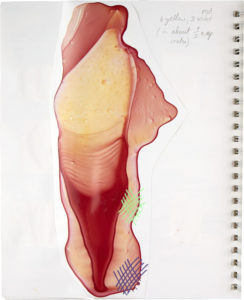
Last summer, my ideas began with phenomenology and moved toward carnival and Bakhtin. I wrote about this in my previous journal entry. One thing I didn’t mention was that in the initial stages of this work I dug through my sketchbooks and found a particular squid-like ink pour. I had saved it because it reminded me of blood plasma or flesh. The form made me wonder if I could make the ink feel even more visceral. I tried dozens of tests: combinations of warm and cool reds, oranges, yellows, and analogous colors, all on synthetic paper. In the end, a mixture of yellow and red-violet outdid them all. This color combination served as a launching point for the new body of work, which I was planning to flesh out at three residencies this summer.
In May I began preparing for my first month-long residency. I wasn’t going to take a car, so I had to choose prudently what to pack. In the end, I left all my pencils behind and brought only gouache, flashe, and acrylic markers—lots of exuberant color.
In June, I arrived at Chanorth in upstate New York and began visually translating social experiences with a focus on humor and various textures encountered in daily life. (I photographed the work below using my phone.)
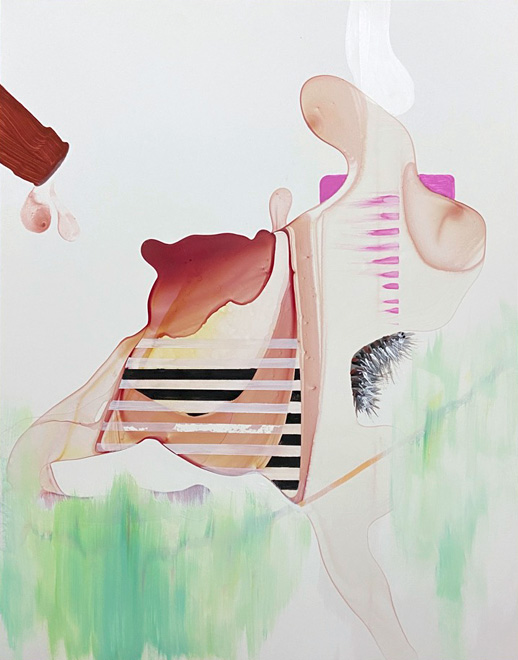
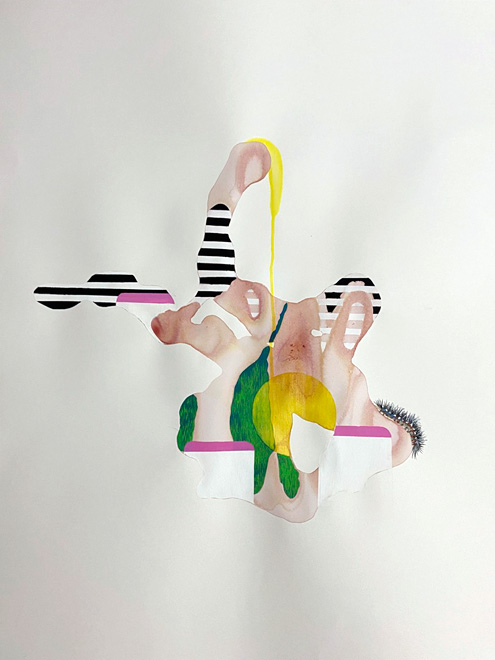
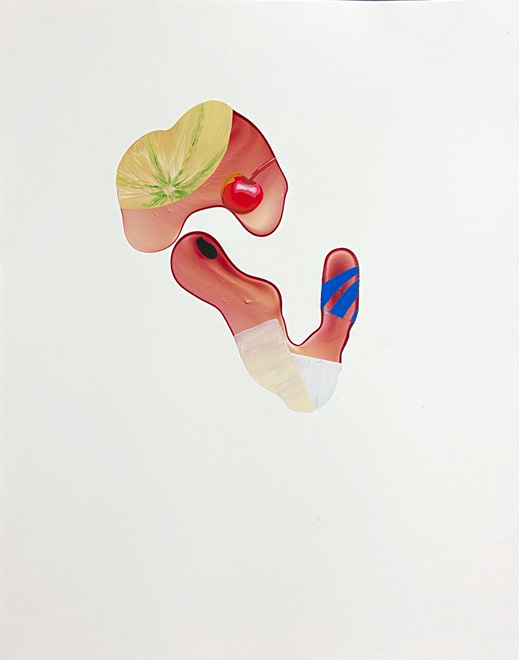
These pieces didn’t engage the ink enough, so my next attempt was to respond to the ink without a superimposed narrative. I imagined a body with Bakhtin’s theory of the carnivalesque and grotesque in mind.
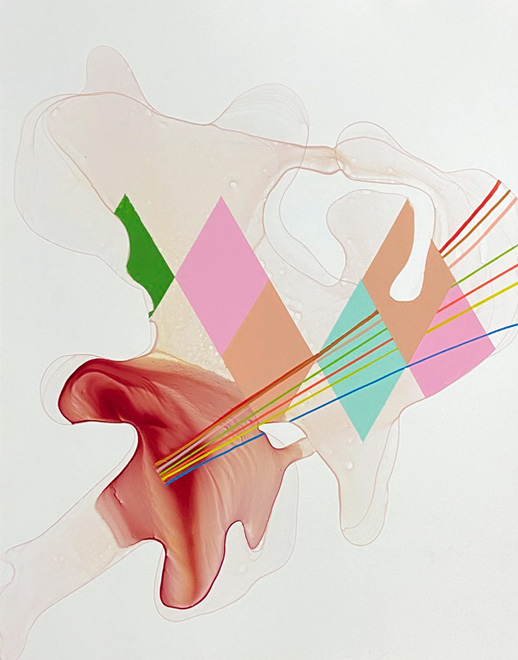
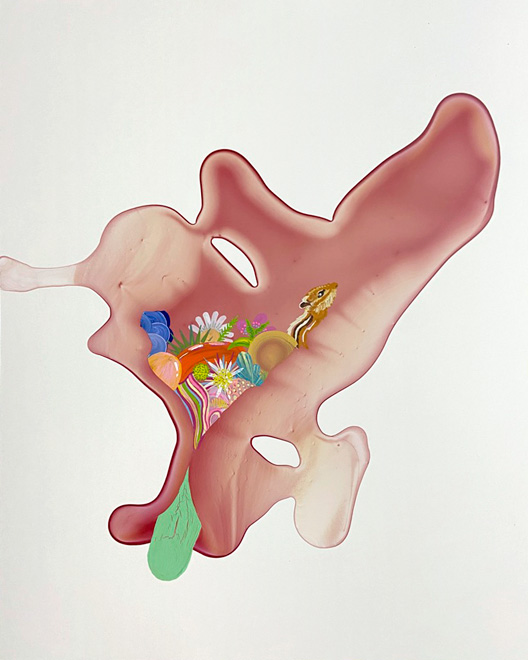
I liked this approach better, which made me wonder how far I could take it: what would be the most minimal addition to the ink that might still emphasize its animacy?
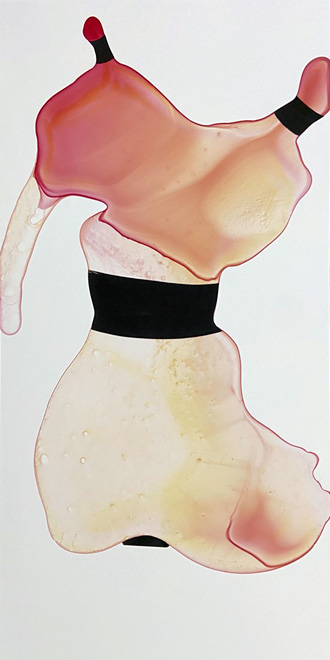
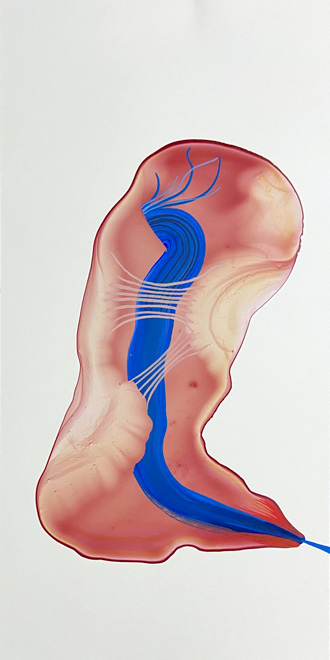
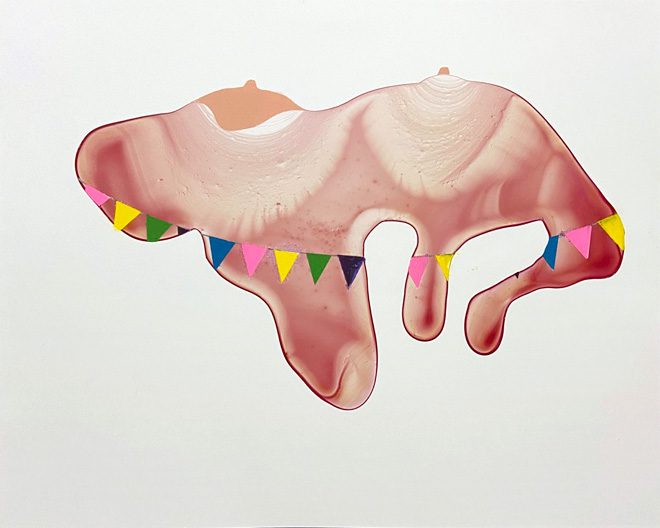
These last pieces worked even better… I ended the June residency on a question: Do I add elements outside of the ink’s boundaries, or leave the white paper blank? I had in mind a piece from 2019 that felt more like a window into a world than an object in space.
In July, I arrived at VCCA France in Auvillar and made additional ink pours. I also compiled a list of objects and adornments that might appear at a contemporary carnival event.
This ink form looked puckered, so I gave it a sour gummy worm.
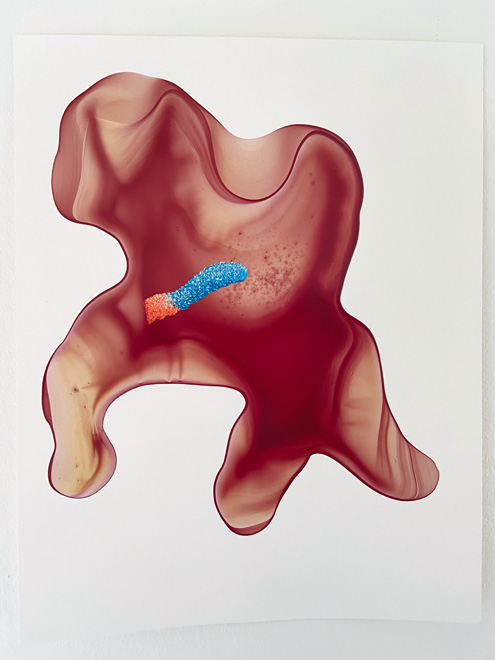
I tried several other experiments, all without veering into the blank space of the paper.
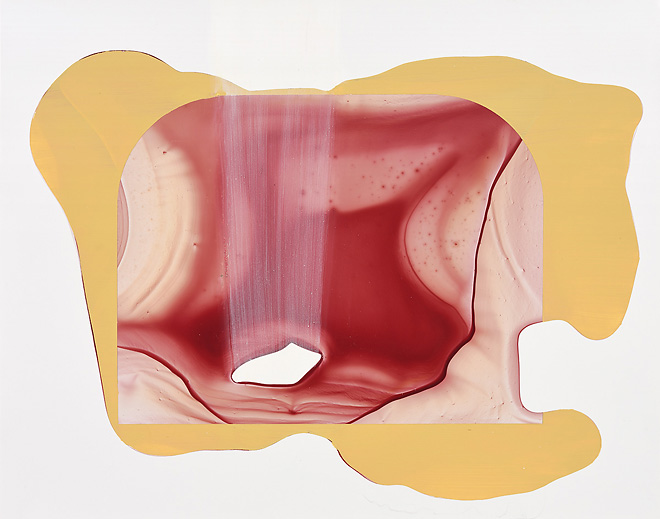
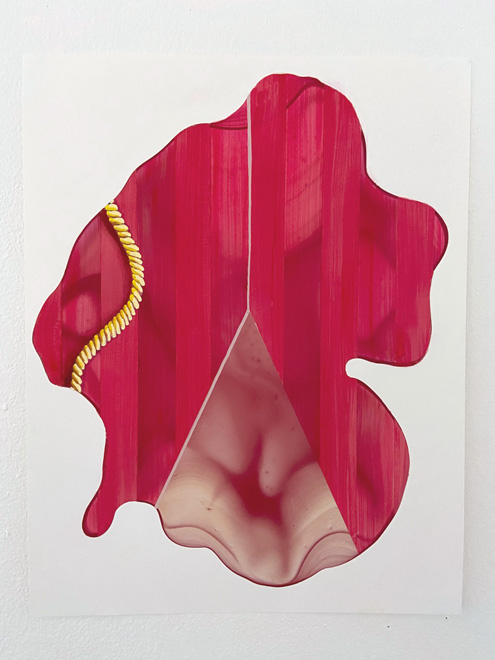
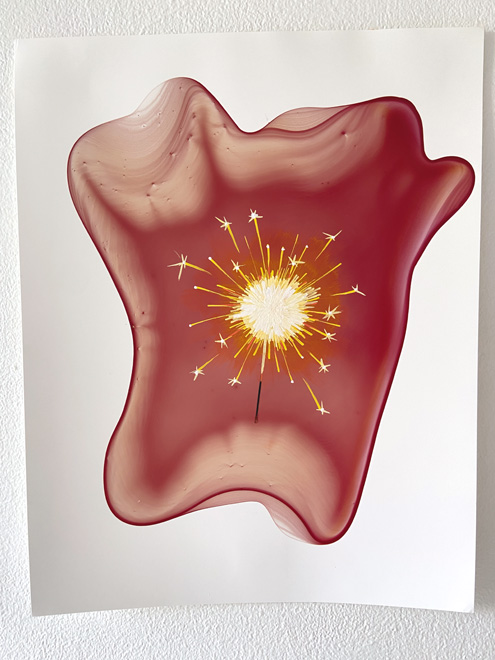
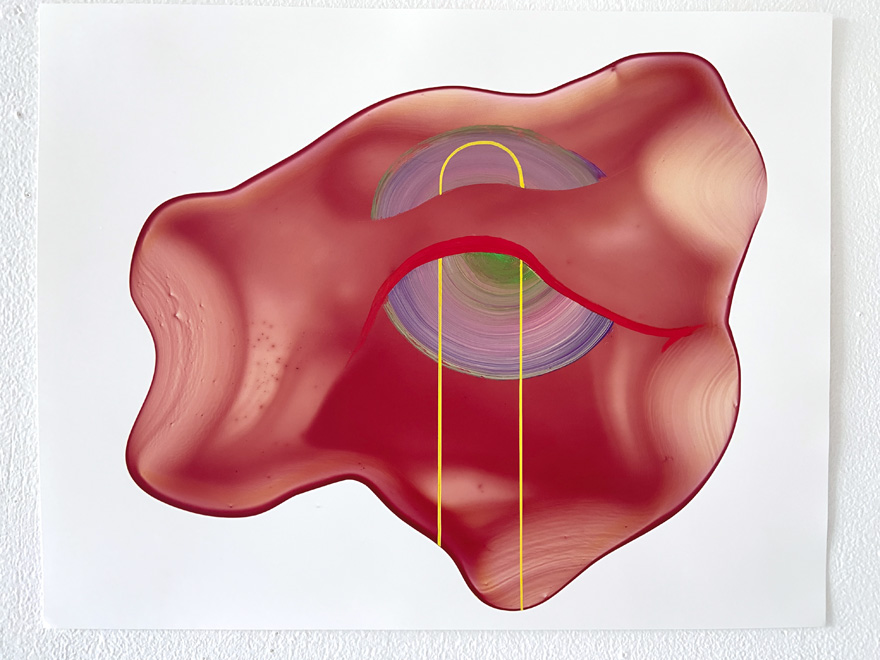
It was in France that I realized just how much the environment influences my work. I had a collection of vintage postcards that we picked up at the local antique market, one of them featuring what I assume was baby Jesus with a laser beam shooting toward him from the sky. One of the pieces above was probably influenced by both that postcard as well as conversations with Jo (another artist in residence) about her own work, which involved analogies between nuclear reactors and spiritual sites.
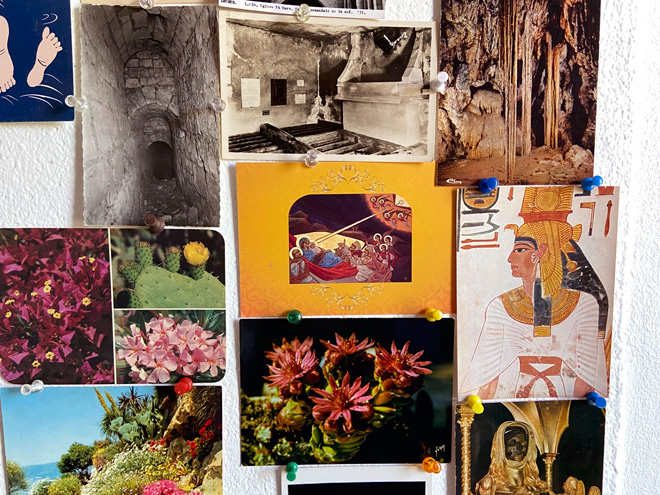
At the beginning of August, I arrived at Ucross Foundation and began my final summer residency by resolving a piece that I had started in France. The ink looked like two cherub butts in clouds of flesh, so I added laser “farts” to emphasize the forms. In addition to the carnivalesque and grotesque, I’ve made an effort to introduce more humor into the work as well.
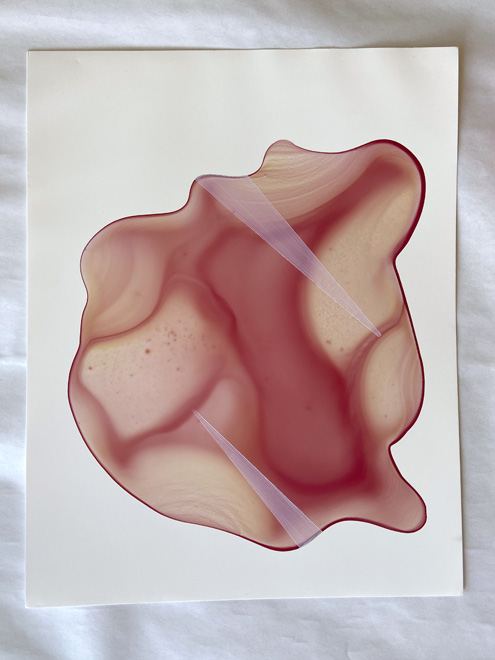
Last week, I decided to pick up an old ink blob from a year ago. It needed a cigarette The piece is not done.

I spent the past few days pouring ink onto larger paper. It’s been a fruitful summer, to say the least.
I recently visited Saint Petersburg Florida and the Dali museum. Your technical skills remind me of Dali. Please take that as a compliment!